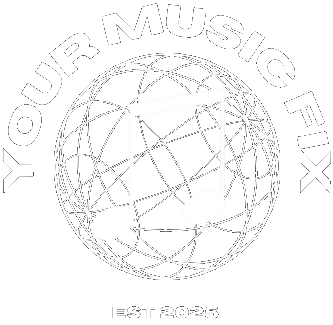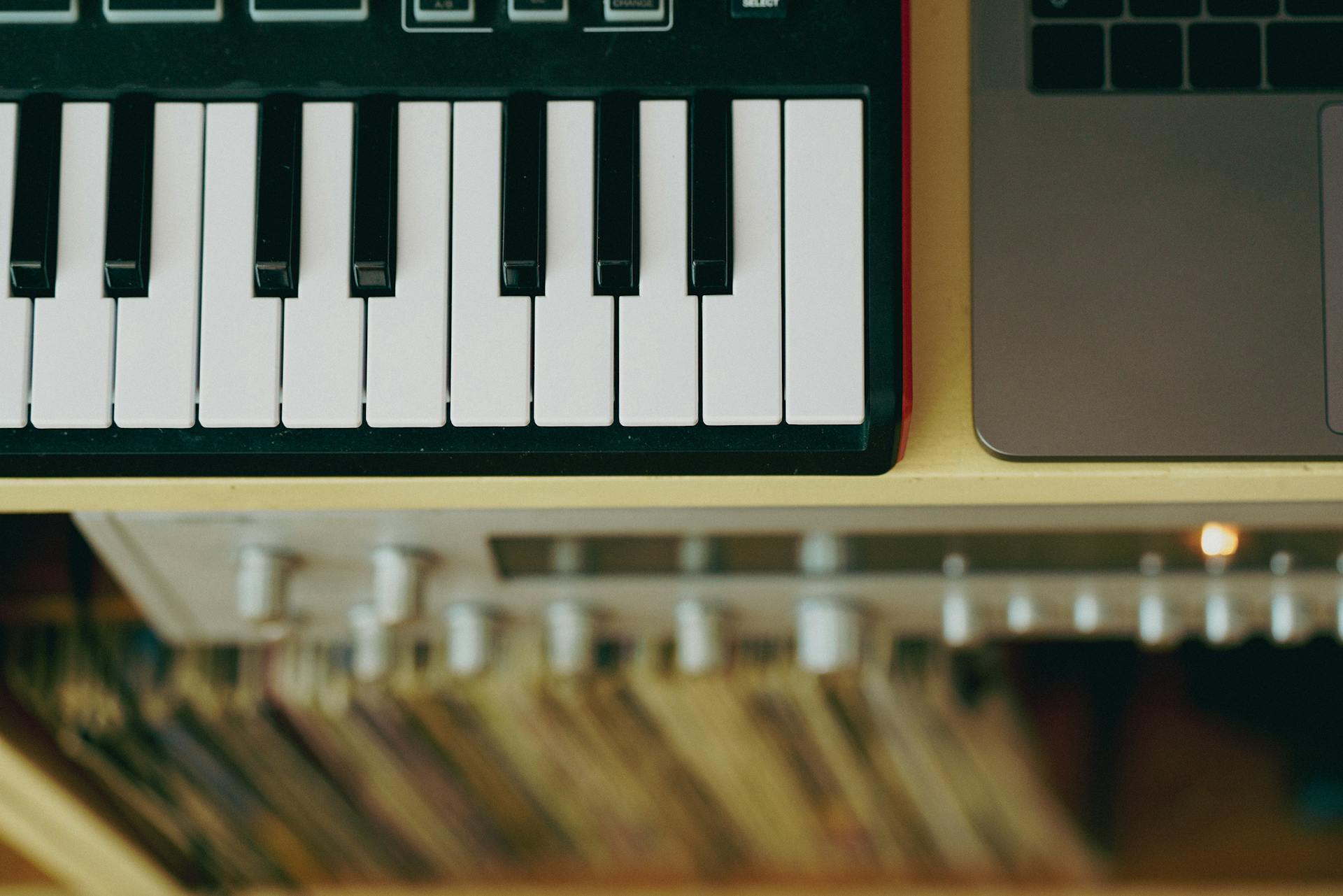This article contains affiliate links. Learn more.
Making music at home has never been more accessible, and a quality MIDI keyboard is the perfect gateway for beginners entering the world of digital music production. Whether you’re crafting beats, composing songs, or learning to play, finding the right beginner MIDI keyboard can make all the difference in your musical journey.
This comprehensive guide aims to help newcomers make informed decisions when selecting their first MIDI keyboard. This guide will walk you through everything you need to know about selecting your first MIDI keyboard, highlighting the best options available on Amazon.
If you’re looking for a digital piano, check out this article over the best digital pianos for beginners.
Table of Contents
What Is a MIDI Keyboard?
A MIDI (Musical Instrument Digital Interface) keyboard isn’t an instrument that produces sound on its own. Instead, it sends digital signals to your computer or other devices, telling them which notes to play, how hard they were pressed, and for how long. Think of it as a sophisticated remote control for your digital music software.
Unlike traditional digital keyboards or synthesizers, MIDI keyboards don’t have built-in speakers or sound generators. They’re designed to control virtual instruments and music production software on your computer. This makes them incredibly versatile tools for music creation.
The beauty of MIDI keyboards lies in their versatility. With the same physical device, you can play piano sounds, orchestral instruments, synthesizers, drum machines, or any other instrument available in your software. This makes them perfect for beginners who want to explore different sounds without investing in multiple instruments.
Why You Need a MIDI Keyboard as a Beginner
For anyone starting their journey into music production or digital composition, a MIDI keyboard offers several significant advantages:
Intuitive Music Creation
While you can input notes using your computer mouse or keyboard, nothing compares to playing them on actual keys. A MIDI keyboard gives you a tactile connection to your music, making composition more intuitive and expressive.

Learning Music Theory
Many beginner MIDI keyboards come with educational features that help you learn scales, chords, and basic music theory concepts. Some even integrate with learning software that provides interactive lessons.
Workflow Efficiency
Creating music with a physical keyboard is significantly faster than clicking notes into a piano roll with your mouse. You’ll spend less time on technical input and more time being creative.
Expression and Nuance
MIDI keyboards capture the velocity (how hard you press the keys) and duration of each note, adding human feel and expression to your digital compositions in a way that’s difficult to achieve with a computer mouse.
Affordability
Entry-level MIDI keyboards are surprisingly affordable, especially compared to traditional instruments. They offer an accessible entry point to music production without breaking the bank.
Key Features to Consider
When shopping for your first MIDI keyboard, several features will significantly impact your experience:
Number of Keys
MIDI keyboards come in various sizes, typically ranging from 25 to 88 keys:
- 25-32 keys: Ultra-portable and perfect for on-the-go producers or those with limited desk space. Ideal for programming beats or simple melodies.
- 49 keys: A sweet spot for many beginners, offering enough range for two-handed playing while remaining reasonably compact.
- 61 keys: Provides more room for complex compositions and proper piano technique without taking up too much space.
- 88 keys: Full-sized piano layout, ideal for classically trained pianists or those planning to develop serious keyboard skills.
For most beginners, a 49-key MIDI keyboard offers the best balance between functionality and space efficiency. However, if you have piano experience or plan to learn proper piano technique, consider a 61-key or 88-key model.
Key Action
The “feel” of the keys significantly impacts playability:
- Synth action: Lightweight keys with minimal resistance. Excellent for fast synth leads and drum programming.
- Semi-weighted: A middle ground that offers some resistance without the heft of fully weighted keys. Great for most beginners.
- Fully weighted: Mimics the feel of an acoustic piano. Best for those with piano training or those looking to develop traditional piano skills.
Beginners without piano experience often find semi-weighted keys most comfortable, as they provide enough resistance for expression without requiring significant finger strength.
Additional Controls
Modern MIDI keyboards offer more than just keys:
- Pitch and modulation wheels: Essential for adding expression and variation to your sounds.
- Drum pads: Perfect for finger drumming and triggering samples.
- Faders and knobs: Allow real-time control of various parameters in your software.
- Transport controls: Let you play, record, and navigate your music software without touching your computer.
For beginners, having at least pitch and modulation wheels plus a few assignable knobs provides a good foundation. As you advance, you may appreciate having more controls at your fingertips.
Connectivity
Consider how the keyboard will connect to your setup:
- USB: Most common and simplest connection, providing both power and MIDI data through one cable.
- 5-pin MIDI ports: Allow connection to hardware synthesizers and older equipment.
- Sustain pedal input: Essential for piano-style playing.
- Expression pedal input: Offers additional control for volume or filter sweeps.
USB connectivity is sufficient for most beginners, though having a sustain pedal input is highly recommended if you plan to play piano parts.
Portability
Consider where and how you’ll use your MIDI keyboard:
- Weight: Lighter keyboards are easier to transport but may feel less substantial.
- Bus-powered vs. AC adapter: USB-powered devices offer more flexibility.
- Physical dimensions: Make sure it fits your workspace.
If you plan to make music in different locations, prioritize compact, bus-powered models that can easily fit in a backpack.
Best MIDI Keyboards for Beginners
Based on build quality, features, and ease of use, here are some of the top MIDI keyboards for beginners available on Amazon:
Akai Professional MPK Mini MK3
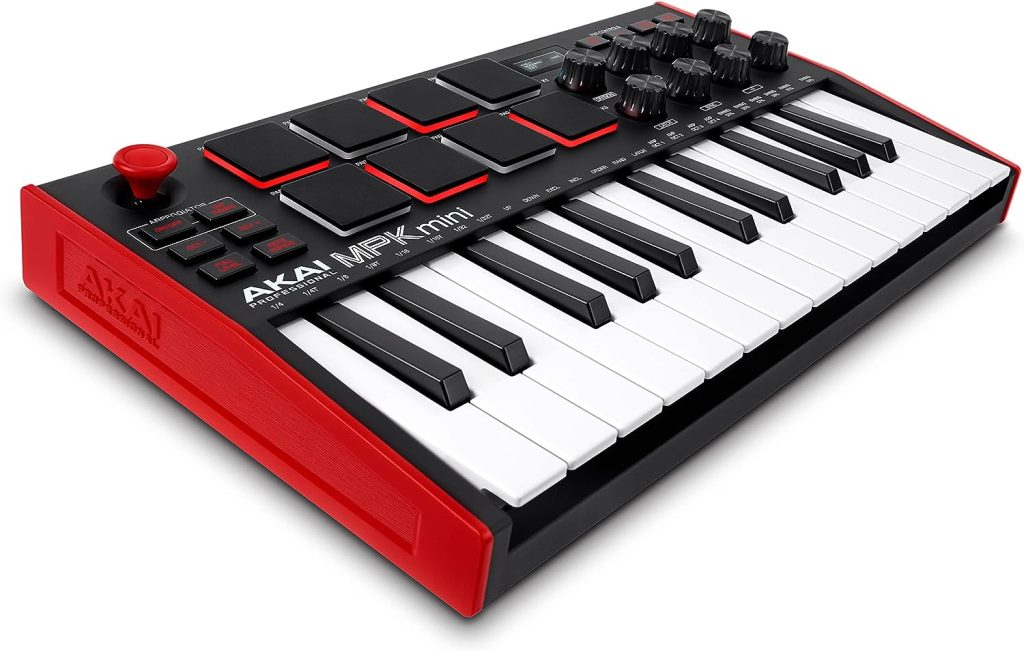
You can find it on Amazon here.
Key Features:
- 25 mini keys
- 8 backlit MPC-style drum pads
- 8 assignable knobs
- 4-way thumbstick for pitch and modulation
- Includes software bundle
- USB-powered
Best For: Beat makers and producers with limited space who want a feature-packed portable option.
Alesis V61 MKII

You can find it on Amazon here.
Key Features:
- 61 full-sized keys with synth action
- 8 velocity-sensitive RGB backlit pads
- 8 assignable knobs
- 9 assignable faders
- Pitch and modulation wheels
- USB-powered
- Dedicated transport controls
Best For: Beginners who want extended keyboard range with comprehensive controls for more detailed sound manipulation.
Novation Launchkey 49 MK3
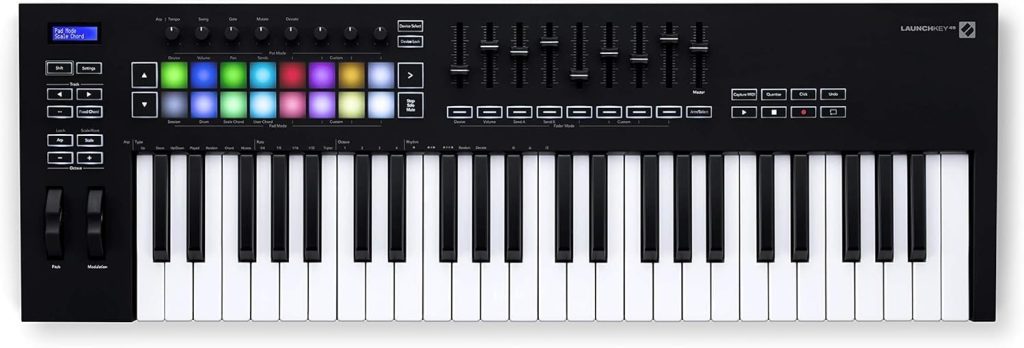
You can get it on Amazon here.
Key Features:
- 49 semi-weighted keys
- 16 velocity-sensitive RGB pads
- 8 rotary encoders
- Deep Ableton Live integration
- Scale and chord modes
- Built-in arpeggiator
Best For: Those planning to use Ableton Live or who want creative performance features.
M-Audio Keystation 61 MK3

You can get it on Amazon here.
Key Features:
- 61 full-sized, semi-weighted keys
- Simple, straightforward design
- Pitch and modulation wheels
- Transport controls
- Sustain pedal input
- USB-powered
Best For: Piano players wanting a larger keyboard with minimal extra features at an affordable price.
Native Instruments Komplete Kontrol A49
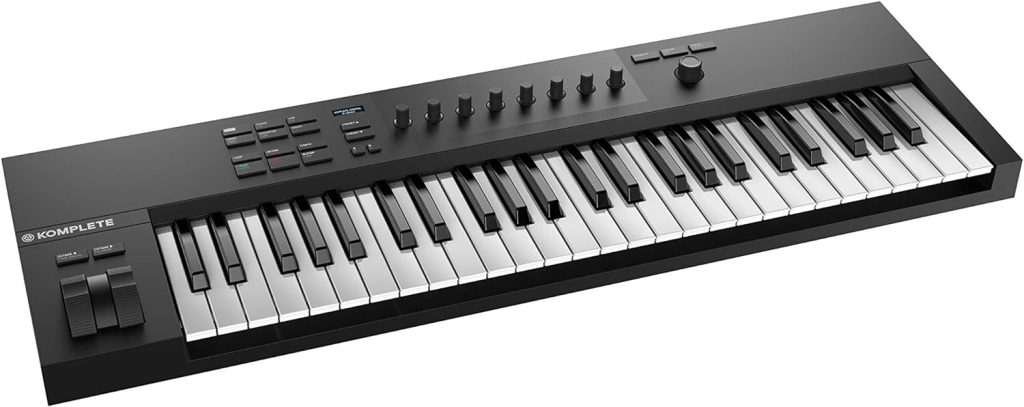
You can get it on Amazon here.
Key Features:
- 49 semi-weighted keys
- Deep integration with NI software
- 8 touch-sensitive knobs
- Smart Play features (scales, chords, arpeggios)
- OLED display
- Transport controls
Best For: Those investing in the Native Instruments ecosystem or wanting high-quality keys with smart features.
Top MIDI Keyboard Brands
When choosing a MIDI keyboard, certain manufacturers have established reputations for quality and innovation. Here are some of the best MIDI keyboard brands to consider:
Akai Professional
Known for their legendary MPC series, Akai brings that expertise to their MIDI controllers. Their products often feature excellent pad response and build quality, with intuitive integration with various software platforms.
Novation
Novation controllers excel at software integration, particularly with Ableton Live. They’re known for innovative features like Scale Mode and innovative arpeggiators that make music creation more accessible for beginners.
Native Instruments
Offering premium build quality and tight integration with their own software ecosystem, Native Instruments keyboards tend to be higher-end options with thoughtful workflow features for producers.
Arturia
Arturia combines vintage-inspired design with modern functionality. Their keyboards often feature excellent key action and analog-style controls that appeal to synthesizer enthusiasts.
Alesis
Known for providing good value, Alesis offers feature-rich controllers at competitive prices, making them popular choices for beginners on a budget.
M-Audio
M-Audio specializes in straightforward, reliable controllers that cover the essentials without unnecessary complexity. Their Keystation series is particularly popular among beginners.
How to Set Up Your First MIDI Keyboard
Getting started with a MIDI keyboard is simpler than you might think:
Physical Setup
- Unbox carefully: Keep all packaging materials until you’re sure everything works properly.
- Place on a stable surface: Your keyboard should be at a comfortable height for playing.
- Connect to your computer: Use the included USB cable (or MIDI cables if applicable).
- Connect a sustain pedal: If you have one and your keyboard supports it.
Software Setup
- Install drivers: Some keyboards require specific drivers, though many are class-compliant and work immediately.
- Install bundled software: Most MIDI keyboards come with free software to get you started.
- Configure your DAW: Open your digital audio workstation and ensure it recognizes your MIDI keyboard.
- Test all functions: Verify all keys, pads, and controls are working properly.
Quick Troubleshooting Tips
- If your keyboard isn’t recognized, try a different USB port or cable
- Check if you need to download updated drivers from the manufacturer’s website
- Some keyboards have different modes that might need to be selected for compatibility with your software
Software Compatibility
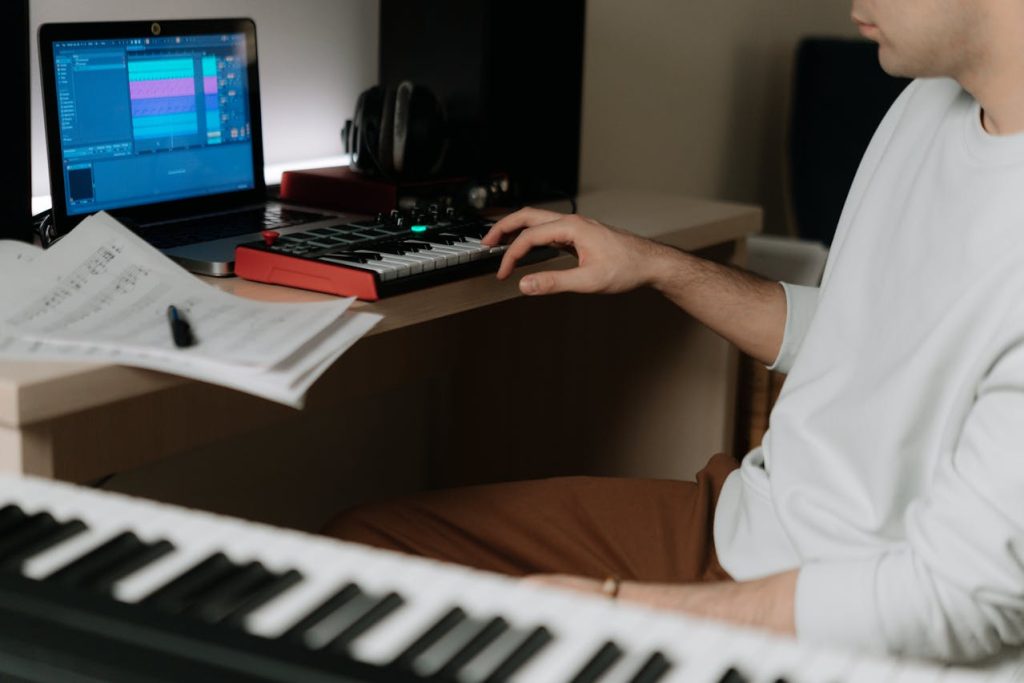
Most MIDI keyboards are designed to work with any music software, but some offer enhanced functionality with specific programs:
Digital Audio Workstations (DAWs)
Popular DAWs that work well with MIDI keyboards include:
- Ableton Live: Particularly well integrated with Novation and Akai products
- FL Studio: Works seamlessly with most MIDI controllers
- Logic Pro: Excellent for Mac users, with automatic mapping for many controllers
- Pro Tools: Industry standard for professional recording
- GarageBand: Free for Mac users and perfect for beginners
Virtual Instruments
Your MIDI keyboard will control virtual instruments such as:
- Synthesizers: Software recreations of classic analog synths or modern digital instruments
- Sample libraries: Realistic recordings of acoustic instruments
- Drum machines: Rhythm instruments and beat creators
- Effect processors: Tools that shape and transform your sounds
Many MIDI keyboards come bundled with lite versions of DAWs and virtual instruments to get you started without additional purchases.
MIDI Keyboard Maintenance
To ensure your MIDI keyboard remains in optimal condition:
Physical Care
- Keep it clean: Use a soft, dry cloth to remove dust. For stubborn dirt, slightly dampen the cloth with water (never spray directly).
- Avoid extreme temperatures: Don’t leave your keyboard in very hot, cold, or humid environments.
- Protect from liquids: Keep drinks away from your keyboard to prevent spills.
- Use a dust cover: When not in use, cover your keyboard to prevent dust buildup.
Software Maintenance
- Update drivers: Check for driver updates from the manufacturer periodically.
- Update firmware: Some keyboards receive firmware updates that add features or fix bugs.
- Check USB connections: Cables can wear out; inspect them regularly for damage.
Common Questions from Beginners
Do I Need to Know How to Play Piano?
No! While piano skills can help, many producers create amazing music without traditional keyboard training. Most modern music software includes tools to help with music theory, such as scale and chord modes.
Can I Use a MIDI Keyboard Without a Computer?
Most entry-level MIDI keyboards require a computer or mobile device to function, as they don’t produce sound themselves. However, some higher-end models can connect directly to hardware synthesizers or have built-in sounds.
What Software Should I Use With My MIDI Keyboard?
Start with whatever software comes bundled with your keyboard. Once you’re comfortable, you might explore other options based on your specific needs and musical style.
How Much Should I Spend on My First MIDI Keyboard?
Entry-level MIDI keyboards with essential features start at very accessible price points. As a beginner, focus on getting the features you need rather than the most expensive option. You can always upgrade as your skills and requirements evolve.
Can I Use a MIDI Keyboard With a Tablet or Smartphone?
Many MIDI keyboards are compatible with iOS and Android devices, though you may need an adapter or specific apps. Check the manufacturer’s specifications for mobile compatibility.
Conclusion
Choosing the best beginner MIDI keyboard doesn’t have to be overwhelming. By focusing on key features like size, key action, and additional controls, you can find an option that matches your musical goals and budget.
The best MIDI keyboard for beginners is one that inspires you to create music regularly. Whether you choose a compact 25-key model for beat-making or a full-sized 88-key controller for piano practice, the right keyboard will become an essential tool in your musical journey.
Remember that your first MIDI keyboard is just the beginning. As you develop your skills and refine your workflow, you’ll gain a better understanding of what features matter most to you. Start simple, focus on making music, and let your equipment needs evolve naturally with your creative process.
Now that you understand what to look for in a beginner MIDI keyboard, you’re ready to make an informed choice and take the first step on your music production journey. Happy creating!
Disclaimer: As an Amazon Associate, I earn from qualifying purchases. All product recommendations are based on research and experience rather than direct testing of every instrument mentioned. Specific prices have been omitted as they vary by retailer and change over time.
